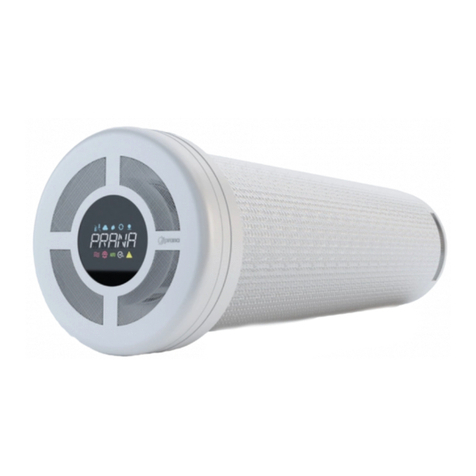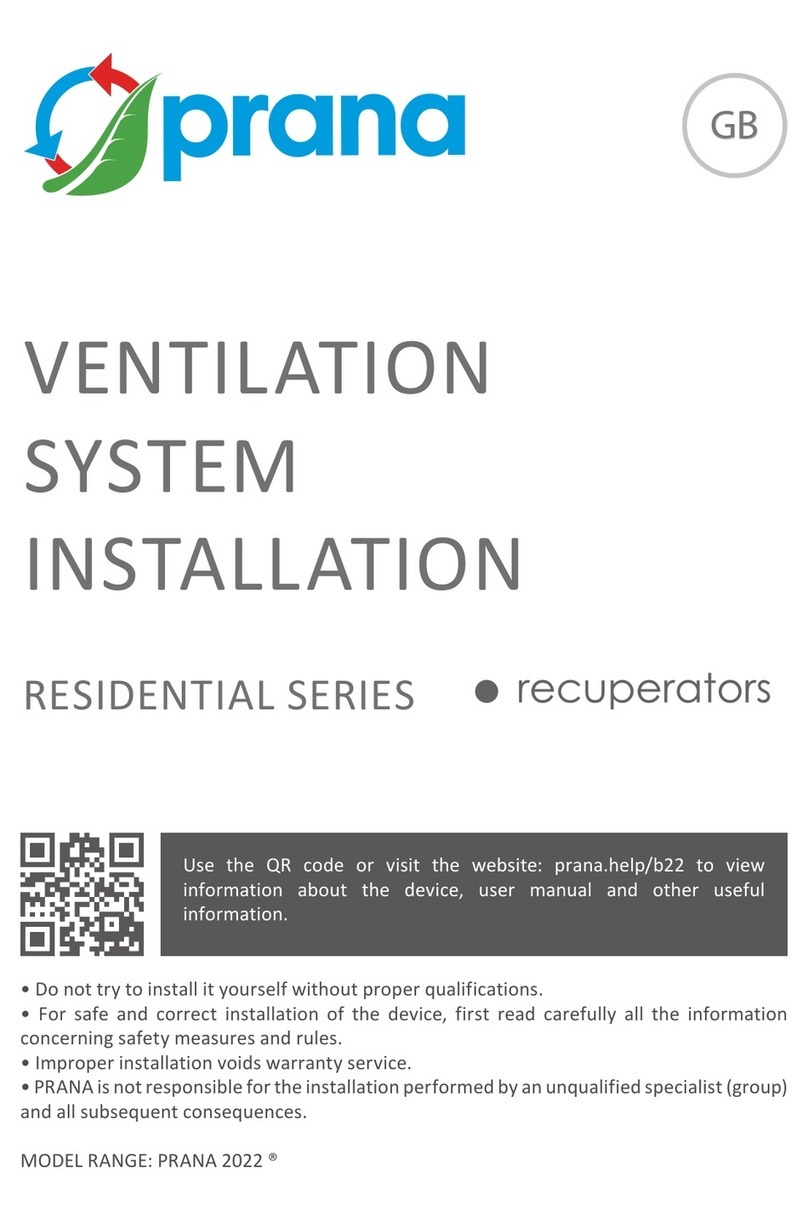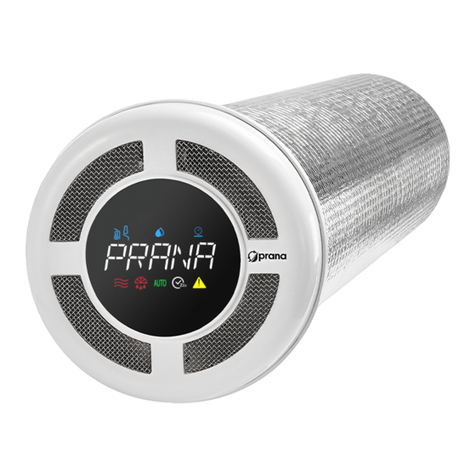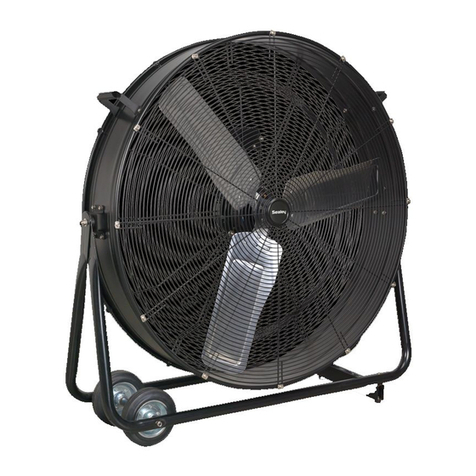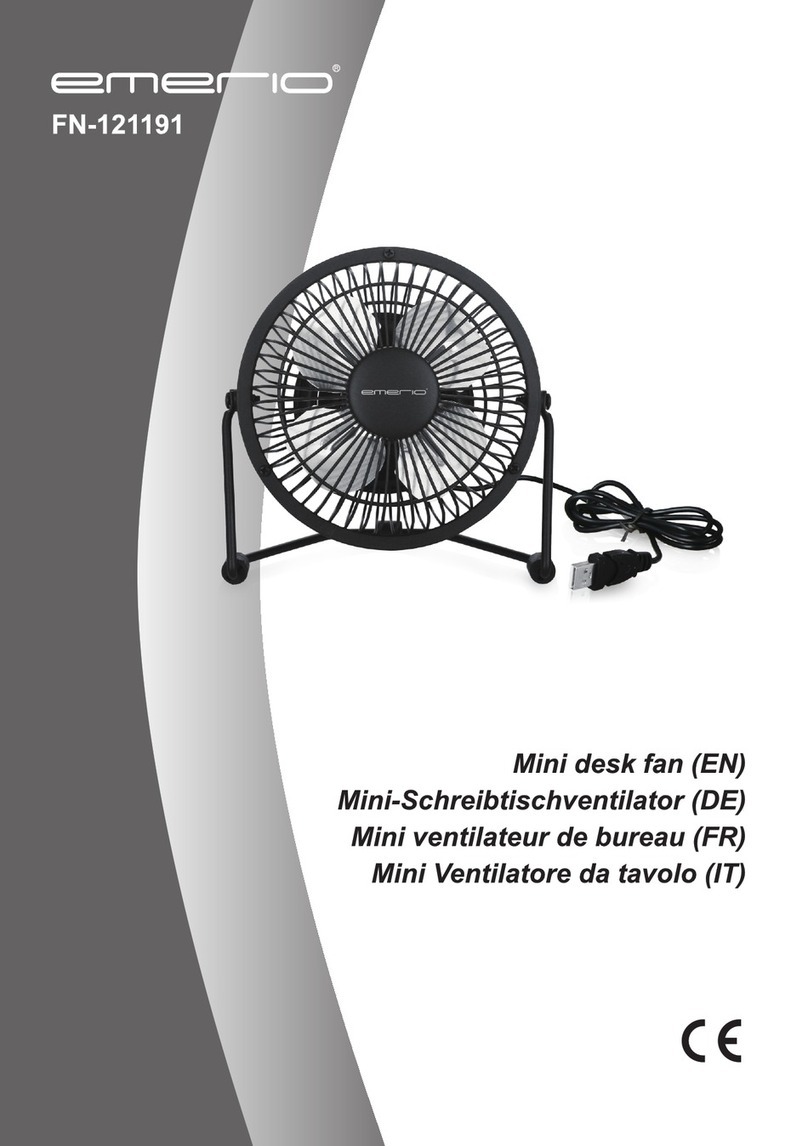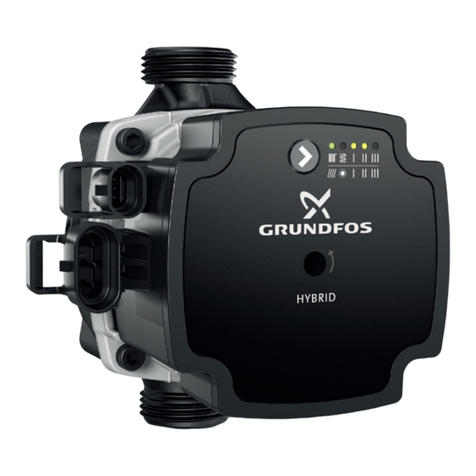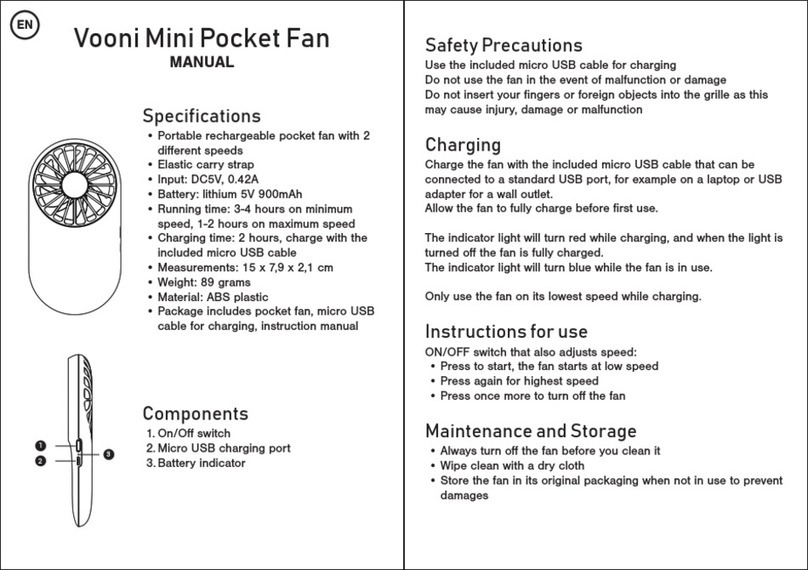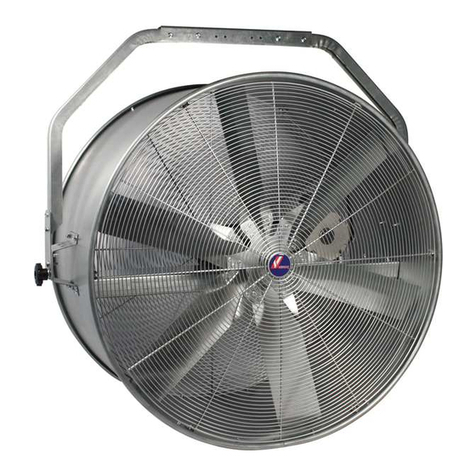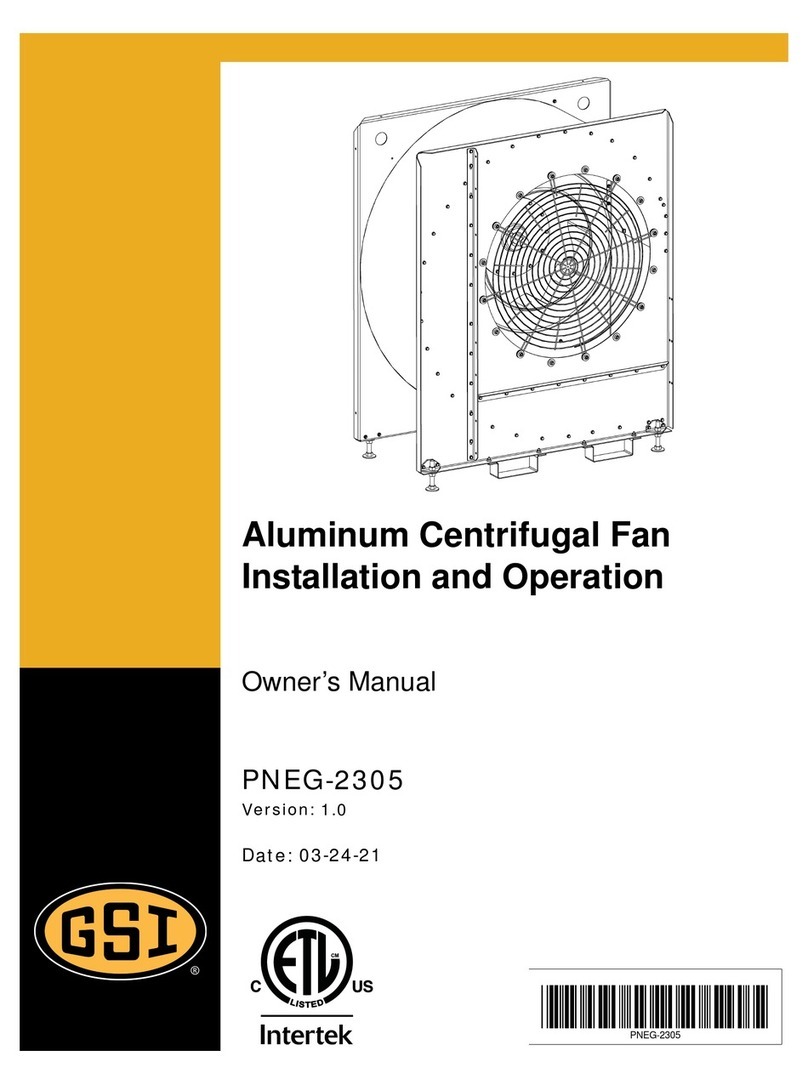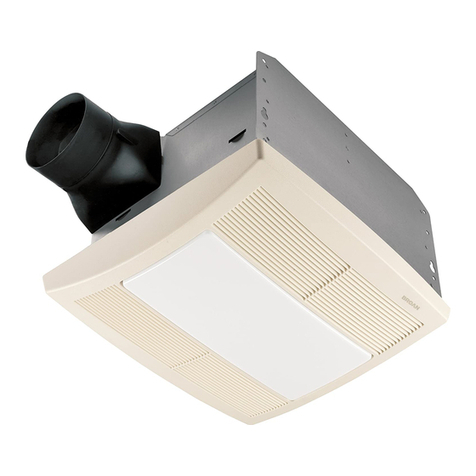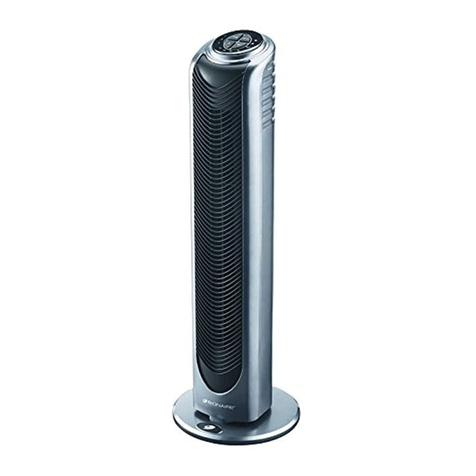prana 340S User manual

VENTILATION SYSTEM
INSTALLATION
INDUSTRIAL SERIES
PRANA 340S
Use the QR code or visit the website:
http://prana.help/p023 to overview useful information such as
ventilation system information, owner’s manual and other.
• Some content may vary from device and may vary by model, region, or software version,
and is subject to change without prior notice warning.
• Read all safety information carefully to ensure safe and proper use of the device.
MODEL RANGE: PRANA 2022 ®
PL

Before using and installing the product read the user’s
manual carefully.
After reading the user manual, keep it for as long as you
use the product and be sure to provide the user manual when
passing the control to another user.

CONTENTS
WARNING AND SAFETY MEASURES .................................... 4
BASIC INSTALLATION RULES ................................................. 8
INTERNAL MODULE INSTALLATION
PRANA-340S ........................................................................ 11
INSTALLATION OF THE WALL MODULE
PRANA-340S ........................................................................ 14
INSTALLATION OF COMBINED MODULE
PRANA-340S ........................................................................ 16
CONNECTION TO THE POWER SUPPLY ............................. 18
WIRING DIAGRAM OF THE CONTROL UNIT
PRANA 340S A ..................................................................... 20
WIRING DIAGRAM FOR AFTERHEATING UNIT
PRANA 340S DP H 220 ..................................................... 22
WIRING DIAGRAM FOR AFTERHEATING UNIT
PRANA 340S DP H 380 ........................................................ 24
WIRING OF DUCT SENSOR
TEMPERATURE (CDT) ......................................................... 26
CONDENSATE DRAIN ........................................................... 27

4
WARNING AND SAFETY MEASURES
• This appliance can be used by children aged from 8 years
and above, people with reduced physical, sensory or mental
capabilities or with lack of experience and knowledge as long
as they are supervised or instructed on the safe use of the
device and understand the hazards involved. Do not allow
children to play with the unit.
Servicing and mounting of the system should not be
performed by kids. The system has to be installed in places
which are excluding kids acces.
• Asphyxiation danger. The appliance may contain small
parts. Some of these small parts may need to be disassembled
during the cleaning and operation maintenance. Be careful
and keep small parts out of the reach of children.
• Begore the use make sure that the installation complies
with the mechanical and electrical regulations which are in
force in the country where the installation was carried out.
• Unqualified users must not install, move, disassemble,
modify or repair the recuperator by themselves. Begore
the use make sure that the installation complies with the
mechanical and electrical regulations which are in force in
the country where the installation was carried out.
• The presence of excessive windage can affect the
performance of the system.
• The manufacturer is not responsible for the installation
that is carried out by an unqualified specialist (or group of

5
specialists) and all subsequent consequences connected with
it. Incorrect installation will invalidate the warranty.
• The fan inside the device rotates during operation. Avoid
putting foreign objects inside the device during operation.
Doing so may result in personal injury.
• The product should only be serviced by a suitably qualified
person with the appropriate electrical safety clearance who
is familiar with the user manual.
• The power supply voltage must be supplied through
a switch that disconnects all supply phases in accordance
with wiring regulations. Do not operate the product without
grounding.
• Before carrying out any maintaining operations, it is
necessary to de-energize the unit (unplug it or turn off the
main power switch and wait for the fans to stop completely).
• Do not dispose the ventilation system with household
waste at the end of its useful life. Dispose of the unit at the
appropriate collection points provided in your country.
• When connecting the product to the mains do not use
damaged equipment and wires. If there is any extraneous
noise, odor, or smoke, immediately turn off the power with
the circuit breaker.
Continued use of the product can cause smoke, fire, electric
shock or injury. Contact the manufacturer’s service center or
dealer in your area for repairs.

6
• The air ducts must be equipped with grills or other device
preventing free access to the fans.
• Do not locate the junction box at the lowest point of the
product to prevent condensation and risk of shorting. Do not
expose the product to water. Do not install or maintain the
product with wet hands.
Always keep the conductive parts of the network dry,
insulated and inaccessible in order to prevent accidents or
short-circuits in the network.
• Do not install heating equipment for air intake. Incomplete
combustion products can cause an accident.
• When using the system with other ventilation systems
in operation in the same room, the performance of the unit
may differ.
• Use the product only for its intended intended use.
• The air being conveyed must not contain inflammable
or explosive mixtures, chemically active vapors, sticky
substances, fibrous materials, coarse dust, soot, grease, or
media that promote the formation of harmful substances
(poison, dust, pathogenic microorganisms).
• To avoid reverse draught in rooms where fireplaces, gas
heaters and other equipment producing or different gas
mixtures are in operation, the «Separate control» mode must
not be used.
•Do not block the condensate drain, as this may cause
equipment failure and water ingress into the room.

7
• The manufacturer declines responsibility for possible
damage directly or indirectly caused by the ventilation
system to people, animals, property if it is caused by failure
of observing the operating rules and conditions, product
adjustment, intentional or negligent actions of the buyer
(user) or third parties.

8
BASIC INSTALLATION RULES
There are three versions of PRANA 340S ventilation
systems:
• Internal version;
• Wall version;
• Combined version (the system is mounted in the plane
of the wall on the other side can have round or flat ducts for
connecting ducts).
In the internal version of the ventilation system it is
mounted under the cealing on in a wall.
In the wall and combined version, the ventilation system is
mounted in a wall opening of the appropriate diameter.
There are restrictions on the length of the operating
module, so you must specify the thickness of the wall
(required for installation) when making an order.
The mounting of the system in the internal version is made
to a solid and stable surface.
The fixing of the PRANA 340S system to the wall must be
made through vibration absorbers to avoid transmitting any
minor vibrations to the ceiling or the wall.
The connection of the ducts to the ventilation system must
be made through vibration-absorbing inserts to eliminate
the transmission of vibration to the ducts.

9
The connection of the ducts and their designation are
determined by the instructions on the housing of the
ventilation system.
The ducts, the ventilation system housing, the ventilation
system motor housing, are insulated with thermal insulation
materials as intended (if necessary).
In order to avoid contamination of the heat exchanger of
the ventilation system, a filter box must be installed on the
outside air duct section and, if necessary, on the exhaust air
ducts from the room.
If the outside air temperature is below +4°C the ventilation
system in the wall and combination variants should be used
with the «Winter mode» and «Mini-heating» functions
activated.
To ensure the optimal operation of the ventilation system
and to reduce aerodynamic losses associated with of air
flow turbulence, it is necessary to have at least 1 meter of
straight ductwork at the recuperator inlets and outlets,
after which off takes, tees and other ductwork elements can
be installed.
For efficient operation of the ventilation system to
ensure the maximum efficiency of the ventilation system,
it is recommended to make aerodynamic calculations of the
duct network. For noise reduction, we recommend installing
sound attenuators.

10
Aerodynamic calculation of air ducts, selection of
ventilation grilles and other additional elements should be
performed exclusively by a professional design engineer.
When the ventilation system is in operation, it is possible
that condensate accumulaes inside the unit. That wat
It is necessary to ensure condensate drainage from the
recuperator (see details in «Condensate drainage» section).

11
INTERNAL MODULE INSTALLATION
PRANA-340S
The ventilation system is mounted under the ceiling or on
the wall in the room using fasteners.
Operation of the system should be carried out in rooms
with internal air temperature from +10 ° C to +40 ° C and
relative humidity up to 80%.
In case of condensation on the housing and on the fan
unit, additional thermal insulation should be done.
Prohibited installation and operation of the ventilation
system to the outside that has direct contact with external
factors.
For the intake of outside and exhaust air, grilles are installed
on the façade of the building, connected to the ventilation
system with air ducts.
The distance between the external grilles is determined
according to the regulations in force in your country.
Make sure that the outdoor air intake grille is positioned
so that no smoke or other harmful gases will enter the room.
If the intake air is contaminated, the quantity and quality
of oxygen in the room may be reduced.
Access must be provided for maintenance of the ventilation
system, calorifiers and filters.

12
If these elements will be hidden in the construction of
ceiling - a revision door must be installed to access each of
the elements.
To avoid discomfort to users the appliance is to be installed
in technical rooms and install soundproofing materials if
necessary.
A list of more installation options for the PRANA 340S
ventilation systems can be viewed in the document «Design
options» at the link:
(prana.help/p023).

13
Example of the correct installation of the PRANA 340S
ventilation system (TYPE1).
Designation and location of air ducts or additional elements
may vary depending on the version.
Unit designations:
A – Tidal air duct;
B – Extract air duct;
C – Heat exchanger;
D – Noise attenuator;
E – Flexible insert;
F – System attachment;
G – Terminal box;
I – Vibration absorber;
J – PRANA-340S;
K – Condensate drain;
M – Exhaust air duct;
N – Outer grille.
O – Filter;
P – Exterior air duct.
JK
G
E
B
A
D
C
F
I
E
MN
OP N
B

14
INSTALLATION OF THE WALL MODULE
PRANA-340S
The ventilation system of the wall version is mounted in
a hole of appropriate diameter (from 350 mm) with a 2-3°
slope towards the street.
The casing (excluding the air intake grille in the rear of the
unit) must protrude at least 1-2 cm outside the wall. Failure
to do so may result in condensed moisture entering the room
and causing failure of the ventilation system.
Before ordering this model it is necessary to note the
thickness of the wall where the air handling unit is to be
installed The thickness of the wall must correspond to the
distance between the air intake grilles, located on the case
of the unit.
The minimum distance between the grids is 350 mm, in
this case the wall thickness must be Lmin ≤ 330 mm. If the
wall thickness is greater, the unit must be manufactured to
order with the required grid spacing.
For service purposes, the ventilation system must be
completely removed from the wall.
Wall-mounted ventilation systems must be equipped with
a mini heater option to prevent the heat exchanger from
icing up.
If a duct heater must be installed, an additional section of
tidal ducting must be installed.

15
Unit designations:
A - Exterior wall;
B - Internal air intake grille;
C - Tidal air spigot;
D - PRANA-340S;
E - Terminal box;
F - Bottom condensate drain;
G - Grille for outside air intake;
H - Exhaust air pipe.
AB
D
H
E
C
FG
Lmin

16
INSTALLATION OF COMBINED MODULE
PRANA-340S
The ventilation system of the combined version is mounted
similarly to the wall version in a hole of appropriate diameter
(from 350 mm) with a 2-3° slope towards the street.
The casing (excluding the air intake grille in the back of
the device) must protrude beyond the wall from the outside
at least 1-2 cm. Failure to do so may result in condensed
moisture entering the room and causing failure of the
ventilation system.
Before ordering this model it is necessary to indicate the
thickness of the wall where the ventilation system is to be
installed.
The thickness of the wall must correspond to the distance
between the air intake grilles located on the body of the
air handling unit. The minimum distance between these
grilles and duct spigots is 350 mm, in which case the wall
thickness must be Lmin ≤ 330 mm (for PRANA-340S TYPE3).
The minimum distance between these grilles and duct
spigots is 440 mm, in which case the wall thickness should
be Lmin ≤ 420 mm (for the RANA-340S TYP6 system) If the
wall thickness is greater, the unit must be custom made with
the required distance between the grilles.
For service, it will be necessary to completely remove the
ventilation system from the wall.
The wall-mounted air handling units must be equipped
with heater elements to prevent the heat exchanger from
icing up.
If it is necessary to install a heater, a section of tidal air
duct must be additionally installed.

17
Unit designations:
A - Exterior wall;
B - Tidal air spigot;
C - Internal air intake spigot;
D - Terminal box;
E - Bottom condensate drain;
F - Grille for outside air intake;
G - Exhaust air pipe;
H - PRANA-340S.
C
A
B
E
C
H
G
F
D
Lmin
The system has a supply and exhaust grille on one side and a
duct connection on the other (internal) side.

18
CONNECTION TO THE POWER SUPPLY
At the external input (230 V/50 Hz or 400 V/50 Hz) there
must be a circuit breaker built into the fixed power supply
network which breaks all phases of the network.
The external circuit breaker must be located so that it is
freely accessible for quick disconnection.
The protection tripping current shall correspond to the
maximum consumption current of the control unit, the
ventilation system and the heater.
The control unit is connected to a 240V or 400V supply
(3x2.5 or 5x2.5) depending on the model and application of
the unit.
The ventilation system is connected to the control unit
with 4x0,75 or 6x0,75 wires, 2 supply (L,N) wires, 2 exhaust
(L,N) wires and 2 mini-heat (L,N) wires (optional).
To connect the supply air afterheating, 5×1,5 (up to 3,6
kW) 5×2,5 (up to 6,0 kW) conductors are used.
To connect the overheating sensor of the heating element
2x0.75 conductors are used.
To connect the temperature sensor in the supply duct,
2x0.75 conductors are used.
The system is controlled by remote control, mobile app,
details can be viewed in the brief user manual.

19
In order to prevent condensation and the risk of short-
circuiting, do not place the junction box at the lowest point
of the product.

20
WIRING DIAGRAM OF THE CONTROL UNIT
PRANA 340S
sleep
supply
extract
on/o on/o on/o
+
-
+
-
+
-
CONTROL UNIT
RECUPERATOR
C10
LN
~230V AC (A)N
CONTROL UNIT PRANA 340 PWM
RELAY HEATR~230V AC (B)SUPPLY EXTRACT
NL NL
LN
NL
Other manuals for 340S
2
Table of contents
Other prana Fan manuals
Popular Fan manuals by other brands

Vents
Vents Quiet-S V user manual
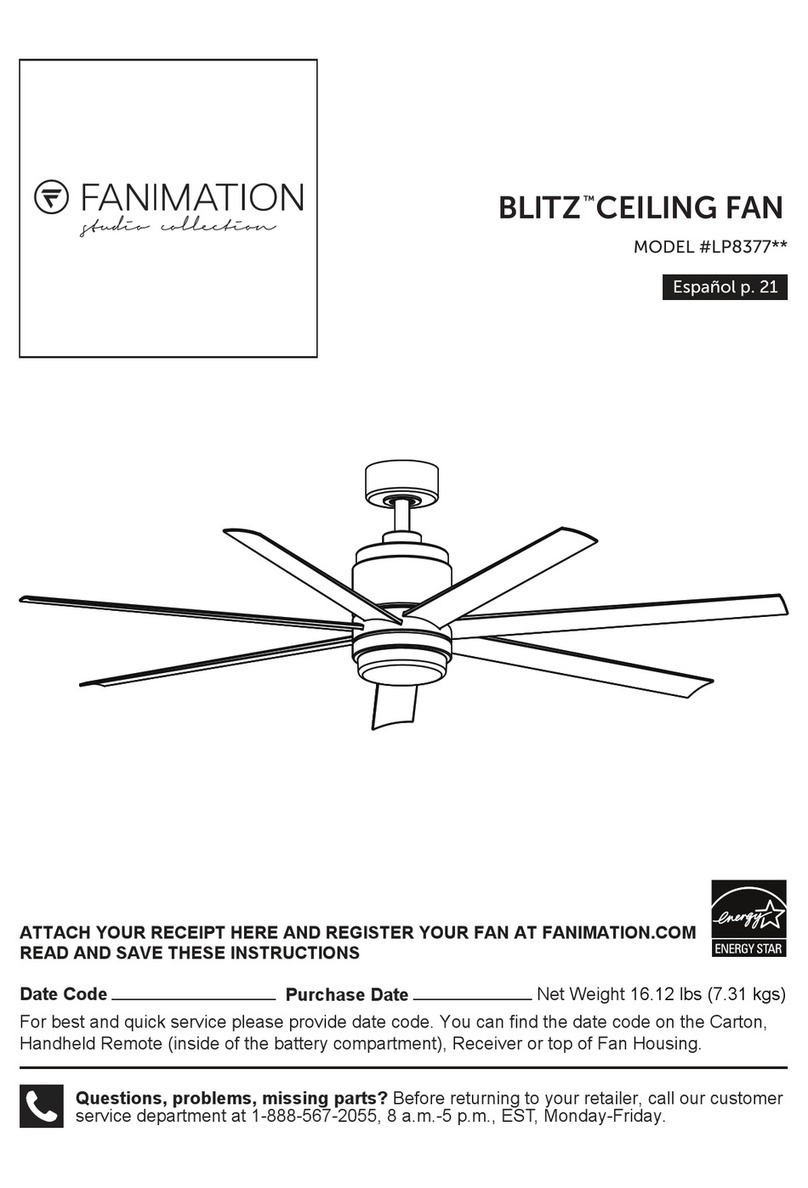
Fanimation
Fanimation BLITZ LP8377 Series manual
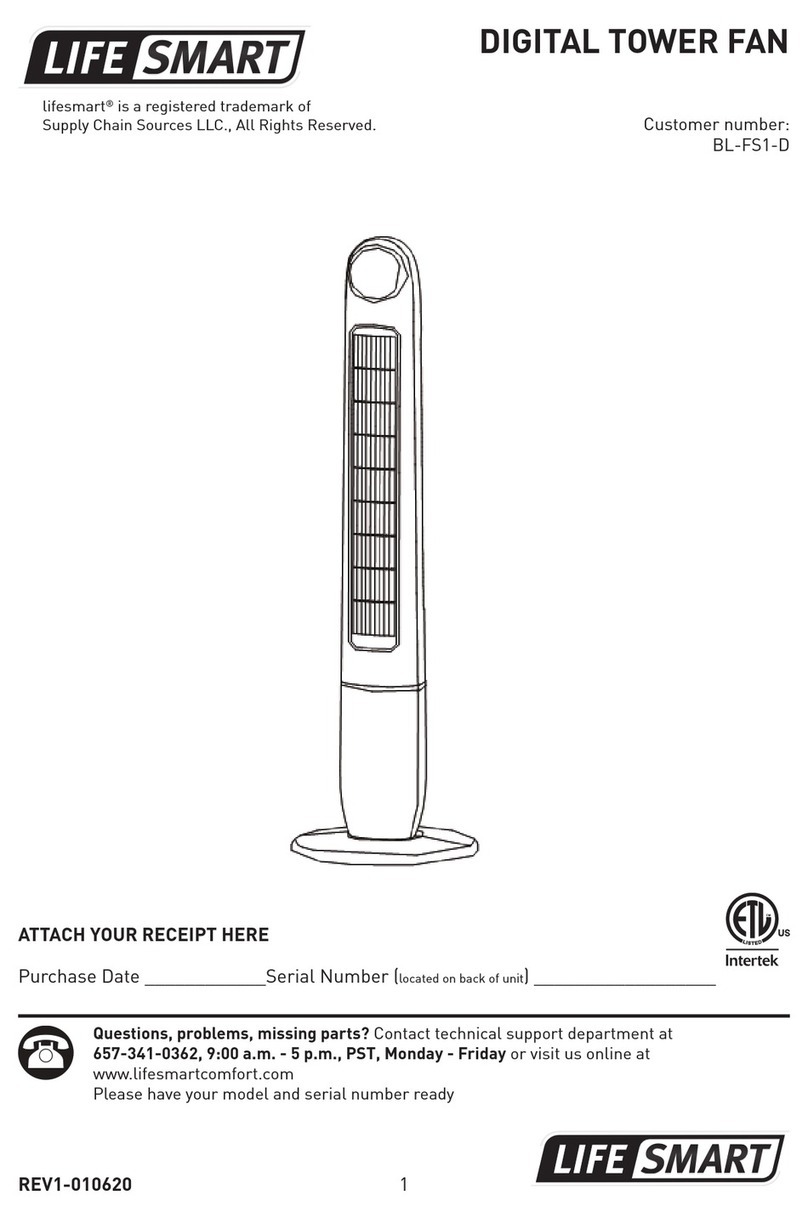
Supply Chain Sources
Supply Chain Sources Life Smart BL-FS1-D manual

Monte Carlo Fan Company
Monte Carlo Fan Company 5CY60XX Series Owner's guide and installation manual

Toshiba
Toshiba VN-250TE owner's manual

Linea 2000
Linea 2000 Domo DO8146 Instruction booklet
